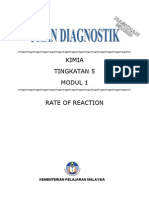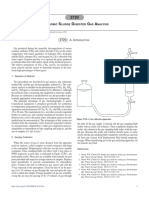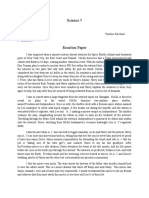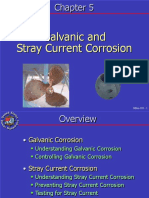0 ratings0% found this document useful (0 votes)
30 viewsExperiment 10b. The Effect of Carbon Dioxide Concentration On Gas Production
Experiment 10b. The Effect of Carbon Dioxide Concentration On Gas Production
Uploaded by
Jan GoIncreasing the concentration of sodium hydrogencarbonate solution added to the jar containing pondweed generally increased the volume of gas produced. This is because carbon dioxide, provided by dissociation of the hydrogencarbonate ions, is a raw material for photosynthesis. However, the rate of gas production may not directly correspond to the rate of photosynthesis, as the percentage of oxygen in the gas bubbles was not measured. Multiple factors like light and temperature could also limit photosynthesis rates at higher hydrogencarbonate concentrations.
Copyright:
© All Rights Reserved
Available Formats
Download as DOC, PDF, TXT or read online from Scribd
Experiment 10b. The Effect of Carbon Dioxide Concentration On Gas Production
Experiment 10b. The Effect of Carbon Dioxide Concentration On Gas Production
Uploaded by
Jan Go0 ratings0% found this document useful (0 votes)
30 views4 pagesIncreasing the concentration of sodium hydrogencarbonate solution added to the jar containing pondweed generally increased the volume of gas produced. This is because carbon dioxide, provided by dissociation of the hydrogencarbonate ions, is a raw material for photosynthesis. However, the rate of gas production may not directly correspond to the rate of photosynthesis, as the percentage of oxygen in the gas bubbles was not measured. Multiple factors like light and temperature could also limit photosynthesis rates at higher hydrogencarbonate concentrations.
Original Description:
Just an work.
Original Title
Carbon
Copyright
© © All Rights Reserved
Available Formats
DOC, PDF, TXT or read online from Scribd
Share this document
Did you find this document useful?
Is this content inappropriate?
Increasing the concentration of sodium hydrogencarbonate solution added to the jar containing pondweed generally increased the volume of gas produced. This is because carbon dioxide, provided by dissociation of the hydrogencarbonate ions, is a raw material for photosynthesis. However, the rate of gas production may not directly correspond to the rate of photosynthesis, as the percentage of oxygen in the gas bubbles was not measured. Multiple factors like light and temperature could also limit photosynthesis rates at higher hydrogencarbonate concentrations.
Copyright:
© All Rights Reserved
Available Formats
Download as DOC, PDF, TXT or read online from Scribd
Download as doc, pdf, or txt
0 ratings0% found this document useful (0 votes)
30 views4 pagesExperiment 10b. The Effect of Carbon Dioxide Concentration On Gas Production
Experiment 10b. The Effect of Carbon Dioxide Concentration On Gas Production
Uploaded by
Jan GoIncreasing the concentration of sodium hydrogencarbonate solution added to the jar containing pondweed generally increased the volume of gas produced. This is because carbon dioxide, provided by dissociation of the hydrogencarbonate ions, is a raw material for photosynthesis. However, the rate of gas production may not directly correspond to the rate of photosynthesis, as the percentage of oxygen in the gas bubbles was not measured. Multiple factors like light and temperature could also limit photosynthesis rates at higher hydrogencarbonate concentrations.
Copyright:
© All Rights Reserved
Available Formats
Download as DOC, PDF, TXT or read online from Scribd
Download as doc, pdf, or txt
You are on page 1of 4
Photosynthesis 10b.
01
Experiment 10b. The effect of carbon dioxide concentration on gas production
(a) Set up the apparatus as described on pp. 10.01 & 10.02 Select a vigorously bubbling piece of
pond-weed and insert it in the microburette.
(b) Place the bench lamp 15 cm from the beaker and do not move it during the course of the
experiment.
(c) Copy the table given below into your notebook.
(d) At an appropriate moment, note the time and draw any gas which has accumulated in the
bulb, up into the tube. Leave the pond-weed to continue bubbling for an exact number of
minutes.
(e) At the end of this time, draw the collected gas into the graduated tube, measure the length of
the gas column and record this in your table.
(f) Now add 5 cm3 sodium hydrogencarbonate solution to the jar from a graduated pipette or
syringe and force the air from the tube into the bulb.
(g) At an appropriate moment, note the time and draw up the collected gas. Allow the pond-weed
to bubble for the same length of time as before and at the end of this time, draw up the
accumulated gas from the bulb and measure its length in the graduated tube.
(h) Add another 5 cm3 sodium hydrogencarbonate solution and measure the gas produced in the
time you have selected.
(i) Continue the experiment by adding successive 5 cm3 volumes of hydrogencarbonate solution
until there is no change in the rate of gas production.
(j) Plot a graph of the volume of gas produced against the concentration of hydrogencarbonate.
Volume of
hydrogencarbonate
in cm3
0
5
10
15
20
25
30
35
40
Volume of gas in mm
Time
Volume per minute
NOTE If bubbling ceases during the experiment it can often be restarted by cutting a small piece
from the stem without having to obtain a fresh shoot and start the experiment all over again
Photosynthesis 10b.02
Experiment 10b. Discussion
If you have already answered the questions on experiment 10a, questions 3-5 can be ignored.
1 What general effect did increasing the concentration of hydrogencarbonate have on gas
production?
2 How could you explain these results in terms of photosynthesis?
3 In this experiment, why is the rate of gas production not necessarily related to the rate of
photosynthesis?
4 What additional information would you need before you could assume that a doubling of the
gas production also meant a doubling in the rate of photosynthesis?
5 In this experiment, the hydrogencarbonate concentration was progressively increased in equal
steps throughout. Did the production of gas also increase in equal steps over the whole range of
hydrogencarbonate concentrations?
6 If the hydrogencarbonate concentration continued to increase beyond the range of your
experiment, would you expect the gas production to continue increasing in proportion? Explain
your answer.
7 What conditions other than the hydrogencarbonate concentration might have been altered
during the experiment? How might these alterations affect the rate of gas production?
Photosynthesis 10b.03
Experiment 10b. The effect of carbon dioxide concentration on gas production
- preparation
Outline (See experiment 10, p 10.01 & 2.) By adding a number of equal volumes of normal
sodium bicarbonate solution the concentration of carbon dioxide available to the plant is
increased and the gas production measured.
Prior knowledge
Sodium hydrogencarbonate is a source of carbon dioxide.
Advance preparation and materials-per group
As for experiment 10 but use a smaller jar or beaker marked at 250 cm3
50 cm3 molar sodium hydrogencarbonate solution (84 g per litre) or soda water, (see note
below). The hydrogencarbonate solution must be freshly prepared.
Elodea shoot about 80 mm long
Apparatus-per group
As for experiment 10 but use a smaller jar or beaker marked at the 250 cm3 level
graduated pipette or syringe, 5 or 10 cm3
container for the sodium hydrogencarbonate solution
NOTES. When using tap-water and hydrogencarbonate solution the results are often rather
erratic but there will usually be a rise in oxygen production and a limiting effect. For more
consistent results it is best to use boiled water to begin with.
Boiled water. Boiling the water for about 10 minutes will remove calcium hydrogencarbonate
and dissolved gases. Store the boiled water in stoppered bottles (e.g. cider flagons). Just before
use shake it with a limited quantity of air to saturate it with oxygen otherwise the gas from the
Elodea will dissolve as fast as it is produced. Soda water can be used instead of sodium
hydrogencarbonate with some improvement in the results.
Black-out. It is not necessary to black-out the laboratory but it is advisable for the students to set
up the apparatus where it will not be affected by changes in the external light intensity.
Results. The experiment should be about 70% successful.
Photosynthesis 10b.04
Experiment 10b. Discussion - answers
1 An increasing concentration of sodium hydrogencarbonate should increase gas production.
2 Since carbon dioxide is one of the raw materials of photosynthesis, an increase in the supply of
hydrogencarbonate ions should enable photosynthesis to proceed faster assuming no other
conditions are limiting.
3 Unless the gas produced by Elodea is pure oxygen it would be possible for the plant to double
its oxygen output without doubling the volume of gas if the proportion of oxygen in the gas
mixture were increased.
4 One would need to know that the percentage of oxygen in the bubbles remains constant, before
it could be assumed that doubling the volume of gas meant doubling the production of oxygen.
5 In practice, the changes in gas production are likely to be rather erratic and not proportional to
the increase in hydrogencarbonate concentration. Even if there is a steady increase in gas
production at first, it will probably reach a constant level at the higher concentrations of
hydrogencarbonate for a variety of reasons.
6 It would not be expected that gas production would continue to increase indefinitely with
increasing carbon dioxide concentration because other factors such as light and temperature
would become limiting.
Also, the concentrated solution of sodium hydrogencarbonate would eventually plasmolyse the
cells. Some students may suggest that at high concentrations sodium hydrogencarbonate might
not be completely dissociated so that the concentration of carbon dioxide is not effectively
increased.
7 Prolonged exposure to the bench lamp might cause a rise in temperature of the water in the
beaker. Since a rise in temperature speeds up many chemical reactions it might also accelerate
some stages of photosynthesis. (In practice, the temperature is unlikely to rise more than
2 or 3 C.)
You might also like
- Rate of Reaction - P&DDocument5 pagesRate of Reaction - P&DJamalDow70% (20)
- Catalase in Potato and Hydrogen Peroxide ConcentrationDocument5 pagesCatalase in Potato and Hydrogen Peroxide ConcentrationAdrian Amiranios89% (9)
- Preparation of IodoformDocument3 pagesPreparation of Iodoformjerry green67% (3)
- 002.0 Surface Sampling TrainingDocument17 pages002.0 Surface Sampling TrainingNguyễnTrường100% (1)
- Molar Volumes of Hydrogen Gas LabDocument4 pagesMolar Volumes of Hydrogen Gas LabHannah Lee100% (3)
- The Rate of Reaction Between Sodium Thiosulphate and Hydrochloric AcidDocument12 pagesThe Rate of Reaction Between Sodium Thiosulphate and Hydrochloric AcidMiriam Barker75% (4)
- Specific Gravity ChartDocument2 pagesSpecific Gravity ChartApril Trish Albaña0% (2)
- All References Data of Chapter 6Document481 pagesAll References Data of Chapter 6Thomas BrouwerNo ratings yet
- Hydrogen Peroxide DecompositionDocument3 pagesHydrogen Peroxide DecompositionRalph John UgalinoNo ratings yet
- Energetics Lab ReportDocument2 pagesEnergetics Lab ReportAmAmAm100% (1)
- Thermal Decomposition of Calcium Carbonate PDFDocument3 pagesThermal Decomposition of Calcium Carbonate PDFSriArthiNo ratings yet
- IntoruductionDocument3 pagesIntoruductionRayya MirzaNo ratings yet
- Distillation QuestionsDocument9 pagesDistillation QuestionsPiping OrdersNo ratings yet
- Suggestion Respiration. Experiment LizooDocument8 pagesSuggestion Respiration. Experiment LizooLizoo NaharNo ratings yet
- Proposal of OelDocument10 pagesProposal of OelJoan MaryNo ratings yet
- Monograph - Carbon Dioxide - 1996Document3 pagesMonograph - Carbon Dioxide - 1996CARLOS IGNACIO OLIVARES HERRERANo ratings yet
- UOP 9 Hydrogen Sulphide in Gases by The Tutweiller MethodDocument4 pagesUOP 9 Hydrogen Sulphide in Gases by The Tutweiller MethodmkmejavierNo ratings yet
- CH Me 6.1studentDocument6 pagesCH Me 6.1studentMar Mar LwinNo ratings yet
- 2720 Anaerobic Sludge Digester Gas Analysis : 1. Selection of MethodDocument5 pages2720 Anaerobic Sludge Digester Gas Analysis : 1. Selection of Methodpollux23No ratings yet
- Lab Report DETERMINATION OF PERCENT COMPOSITION IN HYDRATE COMPUNDSDocument6 pagesLab Report DETERMINATION OF PERCENT COMPOSITION IN HYDRATE COMPUNDSRikachu100% (1)
- Lab 12 - Molar Volume of A GasDocument6 pagesLab 12 - Molar Volume of A GasAnonymous WI0nbsNo ratings yet
- Measuring Soil C Mineralization Rates: Basic IdeaDocument3 pagesMeasuring Soil C Mineralization Rates: Basic IdeamarinellaNo ratings yet
- Chemistry Coursework LayoutDocument7 pagesChemistry Coursework Layoutf5d5wm52100% (2)
- 7.5 CompleteDocument12 pages7.5 Completeep1c19No ratings yet
- Inherent in An Experiment Sources of ErrorsDocument9 pagesInherent in An Experiment Sources of ErrorsfynnkohkexuanNo ratings yet
- R 1 & 2 2023 CHEMISTRY PRACTICAL TRAINING (1)Document15 pagesR 1 & 2 2023 CHEMISTRY PRACTICAL TRAINING (1)siyameannieNo ratings yet
- SCH4C Percentage YieldDocument8 pagesSCH4C Percentage YieldSteve M HallNo ratings yet
- Lab ReportDocument7 pagesLab Reportapi-361658127No ratings yet
- Lactic Acid Determination 1Document24 pagesLactic Acid Determination 1madads25586100% (1)
- Fe CL 3Document11 pagesFe CL 3chemikanthNo ratings yet
- Naskah Murid Modul 1-Rate of ReactionDocument14 pagesNaskah Murid Modul 1-Rate of ReactionIza MohdSabriNo ratings yet
- Chemistry Paper 5 Notes: For Planning SectionDocument6 pagesChemistry Paper 5 Notes: For Planning SectionAyatta23No ratings yet
- A Class Eight Teacher Assembles The Following MaterialsDocument8 pagesA Class Eight Teacher Assembles The Following MaterialsRaytone Tonnie MainaNo ratings yet
- Chemy Exp 2Document6 pagesChemy Exp 2Nur AthirahNo ratings yet
- Lab Tech7Document16 pagesLab Tech7yasir aliNo ratings yet
- Experiment To Investigate How Enzyme Concentration Can Affect The Initial Rate of ReactionDocument4 pagesExperiment To Investigate How Enzyme Concentration Can Affect The Initial Rate of ReactionJan StankiewiczNo ratings yet
- O Level Physics 2023-2025 ATP TipsDocument7 pagesO Level Physics 2023-2025 ATP TipsAmy WolmesNo ratings yet
- Refer To Health & Safety and Technical Notes Section Below For Additional InformationDocument5 pagesRefer To Health & Safety and Technical Notes Section Below For Additional InformationĶxňğ ŘeňňyNo ratings yet
- p5 TipsDocument10 pagesp5 TipsCh PengNo ratings yet
- Lab Report 2 Water of HydrationDocument4 pagesLab Report 2 Water of HydrationsayaanaNo ratings yet
- Effect of CO2 On Photosynthesis (Corrected Method) - 1Document1 pageEffect of CO2 On Photosynthesis (Corrected Method) - 1Shontel ArcherNo ratings yet
- NcseDocument8 pagesNcsebairiabhilash05No ratings yet
- Bio S5 SBADocument5 pagesBio S5 SBAWONG EVELYNE JADENo ratings yet
- Spectrophotometric Determination of Hydrogen SulfideDocument3 pagesSpectrophotometric Determination of Hydrogen SulfideVictor HugoNo ratings yet
- Garret Gas TrainDocument6 pagesGarret Gas Trainlicheng6820No ratings yet
- Decomposição Do Clorato de PotássioDocument5 pagesDecomposição Do Clorato de PotássioVitorArrudaNo ratings yet
- Grade 11 Properties of Oxides 2010 - 2011Document5 pagesGrade 11 Properties of Oxides 2010 - 2011ManTaoNo ratings yet
- A Level Chemistry Core Practical Sample Teacher Worksheet AccDocument1 pageA Level Chemistry Core Practical Sample Teacher Worksheet AccWeb BooksNo ratings yet
- Respirometer BD New 2012Document35 pagesRespirometer BD New 2012Janiah Aaliyah M. DrakesNo ratings yet
- Lab Two: Enzyme Catalysis Adrienne Harreveld Period 4 Ap BioDocument7 pagesLab Two: Enzyme Catalysis Adrienne Harreveld Period 4 Ap BioAdrienne HarreveldNo ratings yet
- Bod Procedure 2Document7 pagesBod Procedure 2kuthappadyNo ratings yet
- 7a Total SO2 Rev 2018 NFDocument11 pages7a Total SO2 Rev 2018 NFSiyabonga mncubeNo ratings yet
- Chemistry Response Celebration 2Document3 pagesChemistry Response Celebration 2Nasra HusseinNo ratings yet
- Xperiments With Arbon Ioxide: HapterDocument12 pagesXperiments With Arbon Ioxide: HapterBashar Al ZoobaidiNo ratings yet
- U8 hw-18Document5 pagesU8 hw-18api-368121935No ratings yet
- US3039853 (Channel Patent)Document2 pagesUS3039853 (Channel Patent)Dewi Aiiu NabillaNo ratings yet
- 2720 Análise Do Gás Do Digestor de Lodo AnaeróbioDocument6 pages2720 Análise Do Gás Do Digestor de Lodo AnaeróbioAdriana CardozoNo ratings yet
- EPA 245.5 HGDocument4 pagesEPA 245.5 HGAarón CespedesNo ratings yet
- DAK Revised SOPDocument10 pagesDAK Revised SOPazlinkadirNo ratings yet
- KjeldahlDocument6 pagesKjeldahlCarlos Andrés MatizNo ratings yet
- The Rate of Reaction of Magnesium With Hydrochloric Acid PDFDocument3 pagesThe Rate of Reaction of Magnesium With Hydrochloric Acid PDFJoko SusiloNo ratings yet
- Noli Me Tangere - Randy S. DavidDocument3 pagesNoli Me Tangere - Randy S. DavidJan GoNo ratings yet
- Sacrament of VocationDocument4 pagesSacrament of VocationJan GoNo ratings yet
- Electron Transport Chain - Cellular Respiration and PhotosynthesisDocument3 pagesElectron Transport Chain - Cellular Respiration and PhotosynthesisJan Go100% (1)
- Brgy. Mojon Community Development Roadmap Planning (FINAL)Document1 pageBrgy. Mojon Community Development Roadmap Planning (FINAL)Jan GoNo ratings yet
- Science 5 Reaction PaperDocument2 pagesScience 5 Reaction PaperJan GoNo ratings yet
- Usulan Obat BaruDocument21 pagesUsulan Obat BaruMas EmNo ratings yet
- Sikagrout Cable PtsaDocument3 pagesSikagrout Cable PtsaYASHICA VAITTIANATHANNo ratings yet
- Chapter 2 - Colloid PropertiesDocument32 pagesChapter 2 - Colloid PropertiesNaz HelmiNo ratings yet
- Chemestry ProjectDocument29 pagesChemestry ProjectRonak BhaleNo ratings yet
- CAPE Chemistry 2016 U1 P2 SolutionsDocument20 pagesCAPE Chemistry 2016 U1 P2 SolutionsDavid StarrNo ratings yet
- SNC - Paliers A Semelle en PDFDocument88 pagesSNC - Paliers A Semelle en PDFDejanNo ratings yet
- Combined Science Chemisttry 2HDocument24 pagesCombined Science Chemisttry 2HAje DavidNo ratings yet
- Formation EvaluationDocument57 pagesFormation EvaluationMikko Delos Reyes100% (1)
- Exothermic and Endothermic ReactionsDocument18 pagesExothermic and Endothermic ReactionsGolden TrioNo ratings yet
- Biology 1 Quarter 2 Module-2Document12 pagesBiology 1 Quarter 2 Module-2Paul David Libo-onNo ratings yet
- Liquid Fuels31 32Document49 pagesLiquid Fuels31 32Maejelou Nayre MoralesNo ratings yet
- Basic Concepts in Org. Chem-Theory Module-4Document37 pagesBasic Concepts in Org. Chem-Theory Module-4Raju SinghNo ratings yet
- Antimicrobial Activity of Melinjo Seed and Peel ExDocument11 pagesAntimicrobial Activity of Melinjo Seed and Peel ExismiNo ratings yet
- Kss Cable TieDocument32 pagesKss Cable Tieismail alwainiNo ratings yet
- Paper 9.5 - H DingDocument22 pagesPaper 9.5 - H Dingmarg1972100% (1)
- Design Project Vertical Axis Wind Turbin PDFDocument49 pagesDesign Project Vertical Axis Wind Turbin PDFandrei catliNo ratings yet
- Algaewatch AnalyzerDocument47 pagesAlgaewatch Analyzerqasim_maqboolNo ratings yet
- Complete Download Patch Clamping An Introductory Guide to Patch Clamp Electrophysiology 1st Edition Areles Molleman PDF All ChaptersDocument49 pagesComplete Download Patch Clamping An Introductory Guide to Patch Clamp Electrophysiology 1st Edition Areles Molleman PDF All Chaptersshorrcasem1q100% (3)
- PTFE Glass TransitionDocument28 pagesPTFE Glass TransitionJosi ArayaNo ratings yet
- Sharp Less EditedDocument34 pagesSharp Less EditedIndrabhan KushwahaNo ratings yet
- Vandex Super Submittal - 0723Document59 pagesVandex Super Submittal - 0723testmailosamaNo ratings yet
- MHRN P BLOCK Group 15 Nitrogen FamilyDocument23 pagesMHRN P BLOCK Group 15 Nitrogen Familysriyabehera11No ratings yet
- Chapter 15 Water and Aqueous SystemsDocument60 pagesChapter 15 Water and Aqueous Systemsapi-240668870No ratings yet
- Procedure Erection Rev.1 PDFDocument25 pagesProcedure Erection Rev.1 PDFFadhil J AhmadNo ratings yet
- Types of Environmental PollutionDocument1 pageTypes of Environmental PollutionLing Siew EeNo ratings yet
- Sigma-Aldrich: Material Safety Data SheetDocument5 pagesSigma-Aldrich: Material Safety Data Sheettpr314No ratings yet
- Galvanic and Stray Current Corrosion: Melec-Ch5 - 1Document36 pagesGalvanic and Stray Current Corrosion: Melec-Ch5 - 1limkokchiang809No ratings yet
- D 1766 - 01 - Rde3njyDocument2 pagesD 1766 - 01 - Rde3njyDr. Ahmed Abdel-HakimNo ratings yet






























































































